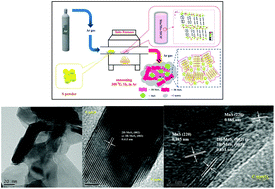One-step synthesis of MnS/MoS2/C through the calcination and sulfurization of a bi-metal–organic framework for a high-performance supercapacitor and its photocurrent investigation†
Abstract
Based on a Mn/Mo-metal organic framework (MOF) precursor, [Mn(4,4′-bipyridine)0.5 MoO4]·1.5H2O, a MnS/MoS2/C hybrid was synthesized through a calcination and sulfurization approach and it is mainly constituted by MoS2/C nanorods and MnS/MoS2/C nanoflakes. The MnS/MoS2/C hybrid delivers a high specific capacitance of 1162 F g−1 at 0.5 A g−1 in 2 M KOH electrolyte, and it possesses a good rate capacity with a retention of 75.7% (880 F g−1) at 10 A g−1, which is due to the synergetic effects of the components MnS, MoS2 and carbon matrix in the hybrid material. The carbon matrix in the hybrid material can not only anchor the active components of MnS and MoS2, but also transport electrons efficiently. The completely exposed Mo and S edges on the preferential 2H-(002) and 3R-(003) facets of MoS2 are beneficial for ion adsorption and electrochemical reaction. An asymmetric supercapacitor constructed by the MnS/MoS2/C hybrid (positive electrode) and activated carbon (AC) (negative electrode) exhibited a capacitance retention of 81% after 5000 galvanostatic charge–discharge cycles (GCD). During the GCD process, the metal sulfides were probably transformed into metal hydroxides in the presence of OH− electrolyte ions. In addition, the MnS/MoS2/C hybrid exhibits a visible light-driven photocurrent response, and DFT calculation proves that it is attributed to the semiconducting feature of MoS2 in the hybrid.



 Please wait while we load your content...
Please wait while we load your content...